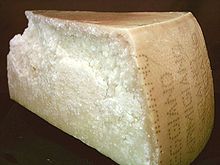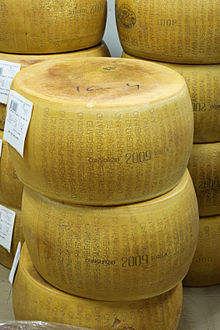Parmesan
Parmesan , colloquially also Parmesan cheese , from Italian Parmigiano , describes an Italian extra-hard cheese made from cow's milk that is particularly suitable for grating as seasoned cheese . The eponymous extra-hard cheese Parmigiano Reggiano has been protected with the DOP seal since October 30, 1955 and has been identified as a product with a protected designation of origin throughout the EU since June 12, 1996 . It has at least 32% fat in the dry matter .
history
The Parmigiano has a very long tradition. Historical sources show that it has been produced in the region of origin for at least 800 years in almost unchanged form. For example, Giovanni Boccaccio mentions and describes Parmigiano by name in his famous Decameron in the 14th century :
Casanova claims in his memoir Histoire de ma vie that "this excellent cheese [...] comes from Lodi and not from Parma ".
In the Simplicissimus von Grimmelshausen , Parmesan is mentioned in 1668: "... I taught his diners how to water the excessively salted butter and thereby pull out the excess salt, but how to scrape the hard cheeses, like the Parmesans, and moisten them with wine".
Manufacturing
According to the DOP regulations, Parmigiano Reggiano may only be produced in the provinces of Parma , Reggio Emilia , Modena , Bologna west of the Reno and Mantua east of the Po . The production is supervised by the Consorzio del Formaggio Parmigiano Reggiano , to which 330 dairies with 2,820 milk producers in the five approved provinces were affiliated in 2018 , who together produced 3.7 million wheels of this cheese. With an average weight of 39.9 kg per loaf, this results in 147,630 t, of which 54,360 t were exported.

One kilogram of cheese requires around 13.5 liters of milk - a loaf of Parmigiano Reggiano therefore requires around 520 liters of milk. The untreated silage free generated raw milk is within two hours after the milking brought in the cheese factory. The milk from the evening milking rests in the dairy in large, low copper kettles until morning, where it creams naturally. The following morning, the cream layer is skimmed off and the partially skimmed milk obtained is mixed with the whole milk from the morning milking and then gently warmed in frustoconical copper kettles and milk ferment from the cheese process of the previous day is added. The coagulation is then initiated by adding calf rennet . With a large, spino -called cheese harp (so-called will of the curd curd ) of the fracture created: The precipitated casein starts from the whey to separate and with it to a fine granular cut. The curd is heated further, under very careful control, which progresses the separation of casein and whey.
After the heating has ended, the cheese granules sink to the bottom of the kettle, from which they are lifted in large cloths, the excess whey dripping off; this is used as feed for fattening pigs (see in particular Parma ham ). The cheese mass lifted out by this process rests for two to three days in round shapes, called fascere . The resulting round loaves are then repeatedly dipped in brine for a period of three weeks. The cheese absorbs the amount of salt necessary for taste and long shelf life. The cheese is then brought to ripen in air-conditioned storage rooms or cellars, where it is stored for at least twelve months, but usually two years or more. During the entire ripening period, the loaves ( called wheels ) have to be cared for, turned over and over again, cleaned and checked.
After the one-year minimum period of aging each wheel of cheese is subjected to experts a test: can Because make for a flawless quality cheese in the maturation in the dough no holes, this is the smell and the sound of the tapping sensory judges. Most of the faulty production found is sold as nameless grated cheese, a smaller part is traded within Italy under the name retinato . Only impeccable loaves are removed or remain in the ripening process for further months and, once this has been completed, may be sold as Parmigiano Reggiano with the seal of the consortium .
use

There are cookbooks that only deal with Parmesan cuisine. In addition to the length of time it matures, the season in which the milk used was obtained primarily influences the taste of the Parmesan. Parmigiano Reggiano is best known as a spicy grated cheese in Italian pasta and pesto dishes. In addition, it is sometimes sliced in thin leaves over steamed or cooked vegetables such as asparagus or fennel . It can also be eaten pure, broken into pieces and coated with honey or consumed with a little balsamic vinegar. The cheese should be scored and broken with a special, short, almond-shaped Parmesan knife so that the structure is retained. The smell and taste are described as fruity-sweet, nutty and spicy.
variants
Age groups
There are different age groups:
- 12 months = nuovo
- 24 months = vecchio
- 36 months = stravecchio
- 48 months = stravecchione
- 72 months = extra stravecchione
Parmigiano Reggiano extra stravecchione that is aged for 72 months is very rarely on the market, as very few producers allow their cheese to mature for six years.
Denomination of Origin
Since, according to a previously widespread opinion, only the name Parmigiano Reggiano should have been protected, other hard cheeses of very different quality were occasionally traded as Parmesan or under similar names. Following the decision of the European Court of Justice in Case C-132/05, it has been clear since 2005 that the term “Parmesan” as a translation or allusion still falls under the designation of origin and is therefore also reserved for the original Parmigiano.
The protection of the designation has been designed to a very large extent by Art. 13 of Regulation 510/2006. Numerous other similar names and allusions to the terms Parmigiano or Parmesan have now been banned by German courts. The semi-finished meal Mirácoli also contained a dry cheese called Parmesello (it was later called: Pamesello ) with such an allusion. In a final decision against a cheese manufacturer from the Allgäu, the 5th Civil Senate of the Berlin Chamber of Appeal also determined the obligation to pay damages for sales activities involving cheese with similar names (judgment of June 15, 2010, Az. 5 U 97/08).
See also
Web links
- Consorzio del Formaggio Parmigiano Reggiano (Italian and English)
Individual evidence
- ^ Casanova, Memoirs 14, p. 151, W. Goldmann Verlag Munich in the translation of Heinrich Conrad
- ↑ Grimmelshausen, Der adventurliche Simplicissimus, fourth book, 1st chapter
- ↑ The bond with the area of origin. In: parmigianoreggiano.com. Retrieved August 10, 2019 .
- ↑ a b Parmigiano Reggiano in Figures 2018. In: parmigianoreggiano.it. Retrieved November 27, 2019 (English, Italian).
- ^ The art of making. In: parmigianoreggiano.com . Retrieved March 29, 2020 (English, Italian).
- ↑ a b Waldemar Ternes , Alfred Täufel, Lieselotte Tunger, Martin Zobel (eds.): Food lexicon . 4th, comprehensively revised edition. Behr, Hamburg 2005, ISBN 3-89947-165-2 .
- ^ Lawsuit by the Commission of the European Communities against the Federal Republic of Germany, filed on March 21, 2005 (PDF)
- ↑ Trademark infringement and competition infringement: Use of the term "Parmesan" as a generic name for hard cheese. KG Berlin 5th Civil Senate, AZ 5 U 97/08. In: juris.de. June 15, 2010, accessed on January 17, 2018 (document excerpt; full text subject to charge).


